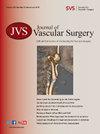Socioeconomic and regional variations in repair modality for ruptured abdominal aortic aneurysms
IF 3.9
2区 医学
Q1 PERIPHERAL VASCULAR DISEASE
引用次数: 0
Abstract
Background
Previous studies report that patients of racial/ethnic minorities more frequently present with ruptured abdominal aortic aneurysms (rAAAs) than their counterparts. The distribution of rAAA treatment modality, whether open aneurysm repair (OAR) or endovascular aneurysm repair (EVAR), by race/ethnicity classification remains uncertain. This study aims to investigate disparities, as represented by race/ethnic classification, median income, and insurance status, in the management of rAAA in a national cohort.
Methods
We conducted a retrospective analysis of patients admitted with rAAA managed with either OAR or EVAR from 2002 to 2020 using the National Inpatient Sample, comparing repair type by race/ethnicity group. Multilevel mixed effects logistic regression models, adjusted for patient- and system-level factors, were used to calculate difference in use of OAR or EVAR dependent on race/ethnicity classification.
Results
We identified 10,788 admissions for rAAA repairs, of which 9506 (88.1%) were White, 605 (5.6%) were Black, 424 (3.9%) were Hispanic, and 253 (2.4%) were Asian/Native American. Asians/Native Americans underwent the highest frequency of OAR as compared with EVAR (61.7% vs 38.3%). In the adjusted model, there was no statistically significant difference in the use of OAR vs EVAR by race/ethnicity classification. In total, primary payer and median income were also not statistically significant predictors of AAA treatment modality.
Conclusions
Our study found no statistical evidence of disparities with respect to race, insurance, or median income and use of OAR or EVAR for the management of rAAA.
破裂腹主动脉瘤修复方式的社会经济和地区差异。
导言:以往的研究报告显示,少数种族/族裔患者比同类患者更常出现腹主动脉瘤破裂(rAAA)。按种族/人种分类的 rAAA 治疗方式(无论是开放式动脉瘤修补术(OAR)还是血管内动脉瘤修补术(EVAR))的分布情况仍不确定。本研究旨在调查全国队列中 rAAA 治疗中的种族/民族分类、收入中位数和保险状况所代表的差异:我们利用全国住院病人样本对 2002 年至 2020 年期间入院接受 OAR 或 EVAR 治疗的 rAAA 患者进行了回顾性分析,比较了不同种族/族裔群体的修复类型。多层次混合效应逻辑回归模型对患者和系统层面的因素进行了调整,用于计算根据种族/族裔分类使用 OAR 或 EVAR 的差异:我们确定了 10,788 例 rAAA 修复入院患者,其中 9,506 例(88.1%)为白人,605 例(5.6%)为黑人,424 例(3.9%)为西班牙裔,253 例(2.4%)为亚裔/美国本土裔。与 EVAR 相比,亚裔/美国本地人接受 OAR 的频率最高(61.7% 对 38.3%)。在调整模型中,按种族/人种分类,OAR 与 EVAR 的使用率在统计学上没有显著差异。总之,主要付款人和收入中位数对 AAA 治疗方式的预测也没有统计学意义:我们的研究发现,在种族、保险、收入中位数和使用 OAR 或 EVAR 治疗 rAAA 方面,没有统计学证据表明存在差异。
本文章由计算机程序翻译,如有差异,请以英文原文为准。
求助全文
约1分钟内获得全文
求助全文
来源期刊
CiteScore
7.70
自引率
18.60%
发文量
1469
审稿时长
54 days
期刊介绍:
Journal of Vascular Surgery ® aims to be the premier international journal of medical, endovascular and surgical care of vascular diseases. It is dedicated to the science and art of vascular surgery and aims to improve the management of patients with vascular diseases by publishing relevant papers that report important medical advances, test new hypotheses, and address current controversies. To acheive this goal, the Journal will publish original clinical and laboratory studies, and reports and papers that comment on the social, economic, ethical, legal, and political factors, which relate to these aims. As the official publication of The Society for Vascular Surgery, the Journal will publish, after peer review, selected papers presented at the annual meeting of this organization and affiliated vascular societies, as well as original articles from members and non-members.

 求助内容:
求助内容: 应助结果提醒方式:
应助结果提醒方式:


